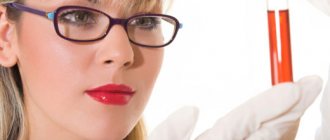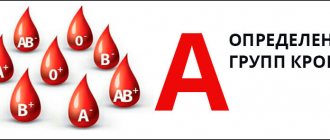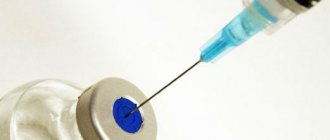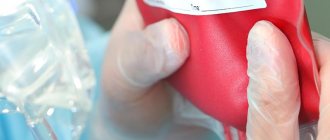AB0 blood group system
Determination of blood group according to the AB0 system is based on the detection of group-specific antigens 0, A, B and isoimmune antibodies anti-A (α) and anti-B (β) in the serum on the surface of human red blood cells. A unique feature of the AB0 system is the presence in human plasma of natural α and β antibodies to the missing antigen. There are six possible allelic antigen options: 00, A0, AA, B0, BB, AB. Phenotypically, four groups are distinguished: 0(I), A(II), B(III), AB(IV) - hetero- and homozygous variants are combined (in Russia they use alphanumeric designations).
Group affiliation according to the AB0 system
| Agglutinogens | Agglutinins |
| 0 | α and β |
| A | β |
| B | α |
| AB | No |
- 0(I): antigens A and B are absent, antibodies α and β are detected (35 - 40% of the world's population);
- A(II): A antigen and β antibodies present (35%);
- B(III): agglutinogen B and agglutinin α were detected (15 – 20%);
- AB(IV): presence of agglutinogens A and B, absence of agglutinins α and β (5 – 10%).
As you move from west to east of Eurasia, the frequency of detection of antigen A decreases, and antigen B increases. Antigen 0 is rare in Asia, but is widespread in the indigenous peoples of South America, Polynesia and Australia. The reason is epidemics of infectious diseases.
The result of blood typing is recorded in the medical history or in the donor’s card. The transfusiologist indicates the date and signs.
In some cases, mild agglutination of red blood cells is observed during typing. The insufficiently pronounced reaction is explained by the presence of weak variants of antigens A and B. Subgroups A1 and A2 are of greatest clinical importance. Weak variants were first discovered in 1911 by scientists Dungern and Hirszeld. Later in 1930, Landsteiner and Levine proposed the subgroup names A1 and A2. A2 occurs in up to 20% in group A and up to 35% in group AB. Serum from individuals from A2 blood samples may contain anti-A1 antibodies: 2% of cases in group A2 and 30% of cases in A2B. Anti-A1 antibodies are dangerous due to agglutination of group A red blood cells.
Method for determining blood groups A2 and A2B
The detection rate of A2 red blood cells varies significantly depending on the reagents used. We present a comparison of study results using various methods for typing blood groups A2 and A2B.
- Anti-A1 (lectin, phytohemagglutinin). Diagnosticum clearly (+++/++++) agglutinates A1 erythrocytes immediately after mixing with the sample. Does not agglutinate A2 or causes minor agglutination at the fifth minute and later.
- Standard isohemagglutinating serums.
- Anti-A and anti-AB zoliclones.
- Anti-A zolicone is weak.
| Number of samples analyzed | Blood type A (II) | Blood type AB (IV) | ||
| Number of samples analyzed | Group A2 (II) in % | Number of samples analyzed | Group A2B (IV) in % | |
| Anti-A1 (lectin, phytohemagglutinin) | 1592 | 14,7 | 357 | 23,5 |
| Coliclones: anti-A, anti-AB | 3599 | 2,1* | 357 | 7,03* |
| Tsoliclone anti-A - weak | 3587 | 4,5* | 357 | 11,2* |
| Standard isohemagglutinating serums | 1592 | 17,4 | 344 | 34,2 |
Note: * - agglutination is weakly expressed, there are small agglutinates on a pink background.
Anti-A1 (lectin, phytohemagglutinin) provides the greatest accuracy of the study. The test is recommended for identifying A antigen subgroups in children under two years of age. The reason is the physiological immaturity of newborn erythrocytes, which leads to erroneous test results with standard isohemagglutinating sera.
In 1930, Landsteiner and Levine discovered the Aint subtype: an intermediate variant between A1 and A2. This antigen is characteristic of Negroids and reaches 8.5% in people with blood group A. In Caucasians, Aint was observed in only 1% of people with the second blood group. In extremely rare cases, a person lacks all antigens of the ABO system. The Bombay phenotype is caused by the hh genotype. In the absence of antigen H, individuals in this category exhibit anti-A and anti-B antibodies.
Method for determining blood groups
Typing according to the AB0 system is carried out in a direct agglutination reaction using standard hemagglutinating sera or typing reagents with monoclonal antibodies. The use of coliclones is preferable due to their absolute specificity: each reagent does not contain admixtures of other antibodies, ballast proteins and infectious factors.
Algorithm for identifying blood group using hemagglutinating sera
To determine the AB0 blood group by the direct method, two series of standard isohemagglutinating sera are used. Prepare two series of sera from three groups with a titer of 1:32 or higher. Use a separate labeled pipette to collect each serum. Prepare AB(IV) serum for control.
- Provide good lighting and an air temperature of 18 – 25 °C.
- Label the tablet: 0(I) – on the left, A(II) – in the center, B(III) – on the right. At the top center, indicate the donor's last name or the number of the blood being analyzed.
- Apply 1 – 2 drops (approximately 0.1 ml) of serum into the wells in two rows according to the plate labeling.
- Using a pipette or glass rod, place one small drop of the red blood cells being tested next to the drops of serum. The volume of serum should be approximately 10 times the volume of red blood cell fluid.
- Mix the drops in the wells with a stick.
- To speed up the reaction, gently rock the tablet.
- After three minutes, add one drop of NaCl to the wells of the plate in which agglutination has begun. Wait two more minutes.
- After five minutes, evaluate the results of the reaction in the running set. In case of unexpressed agglutination, add one more drop of NaCl.
Reaction results:
- A negative reaction in three wells indicates the absence of antigens on the red blood cells of the test sample. Blood belongs to group 0(I).
- Agglutination in wells with sera 0(I) and B(III) indicates the presence of agglutinogen A and belonging to group A(II).
- The onset of a reaction with sera 0(I) and A(II) indicates the presence of antigen B and group membership B(III).
- The reaction results in all wells indicate the presence of agglutinogens A and B and correspond to the fourth group AB(IV).
In the latter case, you should make sure that there is no nonspecific reaction: apply 2–3 drops of serum corresponding to group AB(IV) to the tablet and add one drop of the analyzed red blood cells. Stir the liquids and evaluate the result after five minutes. The absence of agglutination indicates belonging to group AB(IV), the presence is a sign of a nonspecific reaction. In this case, as well as in case of mild agglutination, repeat the study with other series of sera.
Technique for determining blood group using zoliclones
Monoclonal antibodies to erythrocyte antigens have replaced isohemagglutinating sera. For each typing, one series of anti-A, anti-B, anti-AB reagents is sufficient. The introduction of monoclonal reagents made it possible to significantly simplify and standardize the AB0 typing technique. Here is a brief step-by-step guide to conducting research on a tablet.
- Provide good lighting. Work at room temperature.
- The object of study is erythrocyte-containing media.
- Label the wells of the plate: anti-A, anti-B, anti-AB, or use a plate with a labeled sticker.
- Apply approximately 0.1 ml of the appropriate monoclonal reagent to each of the three labeled wells.
- Add approximately 0.03 ml of red blood cells to be analyzed next to each drop of diagnostic solution.
- Mix the reagent with the red blood cells in the wells using separate individual glass rods.
- Rock the tablet for about three minutes.
- Check for agglutination in the wells.
Usually the reaction is detected within the first seconds after mixing. In this case, weak variants of antigens A and B may cause later agglutination.
blood sample collection
introducing the sample into the well
tablet with added samples
adding zoliclones
tablet with erythrocytes and zoliclones
mixing test samples with reagents
Indirect typing method: algorithm of actions
The determination method is based on the interaction of erythrocytes from pre-typed individuals of groups 0, A, B or a mixture of erythrocytes from several same-group donors with isohemagglutinins α and β in the test serum.
Use dry, clean pipettes when handling each typing reagent. Rinse stir sticks and pipettes in 0.9% NaCl solution.
- Prepare a plate or tablet. Provide good lighting in the room.
- Draw 3–5 ml of blood without stabilizer into a test tube. Let the serum sit for 1.5 - 2 hours at room temperature.
- Wash test red blood cells in 0.9% saline solution. Prepare a 5% suspension.
- Label the sections on the tablet: 0(I), A(II), B(III).
- Place 2 drops (approximately 0.1 ml) of plasma to be analyzed into each of the three wells.
- Add approximately 0.03 ml of test red blood cells to the wells.
- Using separate sticks, mix the typed red blood cells with the serum.
- Rock the tablet gently for 5 minutes.
- Conduct a visual assessment of the results of the agglutination reaction in transmitted light.
Conclusion about group affiliation
| Results of plasma analysis with standard red blood cells | Group affiliation | ||
| 0(I) | A(II) | B(III) | |
| — | + | + | 0(I) |
| — | — | + | A(II) |
| — | + | — | B(III) |
| — | — | — | AB(IV) |
+ — presence of agglutination, — — negative result of the reaction.
- 0(I): reaction in wells A(II), B(III) (antibodies α and β detected).
- A(II): agglutination with erythrocytes B(III) (β agglutinins detected).
- B(III): agglutination in well A(II) (α agglutinins determined).
- AB(IV): no reaction results in all wells (no antibodies detected in plasma).
Rhesus system
Levine and Stetson discovered Rh antigens in 1939. Scientists studied the reasons for the development of hemolytic reactions in women in labor during transfusions of husbands' erythrocytes identical in the AB0, MN and P systems. A year later, Landsteiner and Wiener produced antibodies by immunizing rabbits with red blood cells from rhesus monkeys. The antibodies are called anti-RH antibodies. The resulting agglutinins entered into an agglutination reaction with the erythrocytes of rhesus monkeys and with the erythrocytes of 85% of New York citizens of the white race. The antigen that caused the formation of antibodies was called RH factor (D factor).
The Rhesus system combines 45 antigens. Agglutinogens are inherited and remain unchanged throughout life. Immunogenicity decreases in the following order: D > c > E > C > e. Each agglutinogen is encoded by one of two closely related genes: RHD is responsible for the production of the D antigen, RHCE is responsible for the production of the Cc and Ee antigens. Rh-positive donors are considered individuals with D, C or E antigens on the surface of red blood cells. In the absence of the above agglutinogens, donors are considered Rh negative.
In rare cases, human red blood cells do not contain any Rh antigen. The phenotype is designated RhNULL. The Xro gene in this case is presented in homozygous form and suppresses the production of all antigens. Holders of the RhNULL phenotype do not exhibit agglutinogenic activity, but have the ability to transmit antigens by inheritance.
Among Europeans, the frequency of Rh D antigen-positive individuals is 85%. There are usually about 10,000 – 30,000 D molecules located on the membrane of red blood cells. There are two special types of D-positive individuals: Du (weak) and Dpartial (partial). The immune system of Du and Dpartial is capable of producing anti-D antibodies.
Weak antigen occurs in 1.5% of Rh-positive individuals and is characterized by a low number (100–500) of D molecules on the membrane. Is immunogenic for Rh-negative individuals. In this case, transfusion of D-positive erythrocytes to patients with weak D may cause sensitization of the donor’s blood cells. Erythrocytes with Du are weakly agglutinated or do not at all enter into a direct agglutination reaction with complete anti-Rh antibodies. Determination of Rh status is carried out using an indirect antiglobulin test. Du carriers are considered Rh-positive donors and Rh-negative recipients.
Partial D is deficient in one or more epitopes of a protein molecule. The immune system of people with Dpartial is capable of producing antibodies to the missing epitopes. Among partial antigen carriers, seven groups of individuals are distinguished. The DVI carriage (only epitope Z is present) has the greatest clinical significance: owners of this category produce antibodies to the unchanged antigen and to partial antigens DI - DV, DVII. The technique for detecting the Rh factor DVI consists in the sequential use of two diagnostic kits: monoclonal IgM anti-D antibodies (coliclone Anti-D-Super or Anti-D IgM) and polyclonal or monoclonal IgG antibodies anti-D (standard universal reagent or coliclone Anti-D D). A negative reaction result in the first and a positive result in the second stage of the study indicates the detection of DVI. Typically, the DVI category corresponds to the CcDee genotype. Pregnant women with DVI who carry a fetus with complete D are prescribed anti-Rhesus immunoglobulin.
Antibodies against Rh antigens are immune. They arise due to isosensitization. Specificity is determined by the antigens that provoke the formation of antibodies. Complete and incomplete antibodies are isolated.
Complete are IgM antibodies. They are distinguished by their large molecular weight and are detected less frequently compared to incomplete antibodies. Capable of agglutinating Rh-positive red blood cells. They are less important during transfusions.
Incomplete ones predominantly belong to the IgG class. They are attached to the surface of Rh-positive erythrocytes without the formation of agglutinates. The gluing of blood cells is carried out in the presence of colloidal solutions and proteolytic enzymes or after treatment with antiglobulin serum. They have a smaller molecular weight compared to full antibodies. Capable of passing through the placenta. During sensitization, complete antibodies are first produced, then incomplete antibodies (IgG immunoglobulins) are produced to a greater extent.
Over 90% of complications during blood transfusions are caused by incompatibility of the donor and recipient with the Rho(D) antigen. The hr'(c) antigen is also of great importance. Agglutinogen is present in 80–82% of the population. The remaining 18–20% of individuals fall into the high-risk group due to the high likelihood of hr'(c) incompatibility with donors and the development of post-transfusion complications.
Technique for identifying the Rh factor using zoliclon Anti-D-Super
Tsoliklon Anti-D-Super is a complete human anti-D IgM antibody. To obtain reliable results, the analyzed sample must contain a sufficient number of red blood cells.
- Provide good lighting and room temperature in the room.
- Place one large drop (approximately 0.1 ml) of Anti-D IgM on the plate.
- Place one small drop (approximately 0.03 ml) of the red blood cells being tested nearby.
- Mix two drops with a sterile stick.
- After 10–15 seconds, gently rock the plate for 20–30 seconds.
- Check for agglutination three minutes after mixing.
If a reaction occurs, the blood is assessed as Rh-positive (Rh+), if there is no reaction - as Rh-negative (Rh-). If agglutination is negative or weak, it is necessary to repeat the test with incomplete anti-D IgG antibodies in order to detect weak or partial D antigen.
reaction result
visual assessment of reaction results in transmitted light
registration of analysis results
Method for determining the Rh factor Du in a tube test
In parallel with the analysis, three control samples are performed: the reagent coliclone Anti-D (anti-D IgG) with standard Rh-positive and Rh-negative erythrocytes, the analyzed erythrocytes with a gelatin solution without the anti-D IgG diagnosticum.
- Place 0.05 - 0.1 ml (one drop) of red blood cells from a clot of coagulated blood or washed from a preservative into a test tube.
- Add 0.1 ml (two drops) of 10% gelatin heated until liquefied at 45 - 50 °C.
- Add one drop of Anti-D Zoliclone (Anti-D IgG).
- Perform mixing.
- Incubate the tube in a water bath for 10–15 minutes or in a thermostat at 48 °C for half an hour.
- Add 5 - 6 ml of isotonic solution.
- Invert the test tube 1 – 2 times.
- Assess for the presence of agglutination in transmitted light.
The absence of reaction results with anti-D IgM and pronounced agglutination with anti-D IgG indicate the detection of weak forms of antigen D. In case of weak agglutination, the test should be repeated in the indirect Coombs test.
Recommendations for therapy
During treatment, it is necessary to take into account the parameters of the circulatory system and hemodynamics. All this is studied by the science of hematology. Every doctor needs to consider several important points.
- Blood clotting parameters
. If a person has excessively thin blood, a small number of platelets and clotting factors, it is not recommended to use drugs that have a thinning effect. For example, Aspirin. - Complications in the form of dysbacteriosis
. There is a certain microflora in the intestines. If the parameters are violated, abdominal pain, increased gas formation, and diarrhea develop. In this case, it is recommended to take probiotics over a long period of time. - Traditional methods
. Plant extracts can be used as an additional method of therapy. Aloe, mint, and rose hips have a great effect, having a positive effect on the composition of the blood, the digestive tract, the urinary system and other parts of the body.
It is necessary to take into account all the doctor’s recommendations so that recovery occurs faster. They do not self-medicate.







